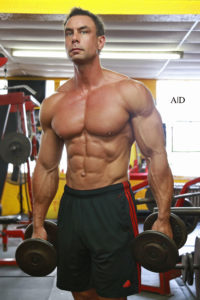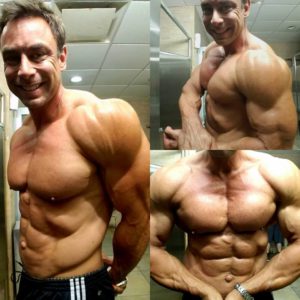 A gladiator chest. Who does not want one? And yet, it is a rare sight, most people have overdeveloped shoulders and very little muscle on the chest despite hours and hours of pounding away. How is that possible? There are a few factors at play that I will outline here
A gladiator chest. Who does not want one? And yet, it is a rare sight, most people have overdeveloped shoulders and very little muscle on the chest despite hours and hours of pounding away. How is that possible? There are a few factors at play that I will outline here
You are simply not activating your chest!
That sounds like a no brainer but it is very common. Having been a personal trainer in NYC for over a decade I can count on one hand the number of good chest workouts I have seen.
Why? Think about it: what is the most common chest exercise for men? the bench, meaning you are pushing a weight up and down. Well, you can not have great chest workouts for men if you are not activating your chest!
OK, great but what is the actual function of the chest?
The chest consists of three separate muscles: the pectoralis minor (which is of no concern to us for now), the clavicular head of the pectoralis major, and the sternal head of the pectoralis major.
When the both heads of the pectorals major work together with
it produces a movement called horizontal abduction. In other words, it brings your arm across the front of your body; for instance when you are doing a fly movement.
A lesser-known function of the pecs is to internally (or medially) rotate the humerus (upper arm bone). Hold your arms out straight with your palms up, then rotate your arms such that your palms are facing down. That is one example of internal rotation of the humerus.
So now you can see you simply punching weight up and down is not going to help you, you need to do a fly movement with the following execution
1. Only go back as far until you flexed your lats.
2. Keep the arms stiff and focus on pushing the elbows together, do not focus on the hands.
3. Always keep the shoulder blades pinched together and held back.
You are injured or about to get injured.
Nobody gets bigger or better when you are not training, right?
When training the chest, injuries in the shoulder and elbow joint are very common and it will be impossible to make progress if your joints are not healthy.
Before you start training, run yourself through the following tests to make sure that you are ready to train.
1. The rotator cuff test:
Sit one a bench, with one foot elevated. Then grab a small dumbbell, prop the elbow against the knee and rotate the weight upward for 10 – 12 reps. If you can not use 8 – 10% of your incline bench weight, you are on the fast track for a blown shoulder.
The cure:
- 3×10 inward rotations at cable
- 3×10 outward rotations at cable
- 3×10 reverse shrugs. This exercise is set up as follows: sit at the lat pull down, with a medium-wide overhand grip. Pull the shoulder blades down for about 2-3 inches without bending the elbows. The goal is to work the lower part of the traps, without involving latissimus or biceps too much.
- 2. The wall slides Test:Stand leaning against a wall, while raising the hands above the head. If the shoulders come off or can’t stay close to thewall, your shoulder flexibility is impaired and an injury is on its way.The cure:
- 3×10/10 barbell pull overs and overhead presses on floor. See above
- 3×10 reverse shrugs
3×10 face pulls
3×10 j-pulls
30 towel/band rotations
3. The push/pull ratio Test:
If your bent over row does not match your incline bench, add 10-20 pull ups every day.

4. The Towel Test:
Grab a towel wider than shoulder width and hold it straight out. Rotate it behind the body and back forward. If you cannot do a full rotation, start with whatever is possible. Do 3×20 reps every day.
The elbow
- A weak grip can equal elbow pain. If you can’t carry a load equal to your bodyweight in your hands for 15 meters, your grip is too weak. Farmer’s walks and walking lunges will help.
- The false grip can boost your maximal strength numbers, but it reduces the capability of the neuromuscular system to produce force through the hands and wrists. It is also dangerous, so always use a thumb wrapping grip.
- If your elbow hurts, use a neutral grip whenever possible (palms facing each other) instead of a pronated or supinated position in your primary lifts. This goes for pulling and pressing.
- If you’ve been making one of the above mistakes and have achy elbows, give self-myofascial release a shot.
Problem No 3: Your volume is too low
Why do we train muscles more than once a week? Simple. Muscle protein synthesis (MPS) which means muscle growth drops back to nearly zero after a day and a half. This means if you train a muscle once a week only, you are leaving 52 chances of growing unused. If you train more often, you will get bigger!
Problem No 4 You are not covering you the strength curve
Each muscle has three positions: stretched, mid range, and contracted. The muscle is very weak at the extremes s(stretched and contracted) and very strong in the middle.
Which is why most of us train the mid range only. That is not a great idea for a few reasons:
You are not training the muscle to its full capacity thereby not maximizing your progress.
A muscle that is not trained in the stretched position tightens up. In case of the chest, that would create a hunched forward, muscle-bound physique.
This makes you more prone to injury as the constant tension on the joints and ligaments will cause problems down the road.
If you train the entire strength curve, these things happen:
The muscle grows more since you are maxing out all the ranges.
You will create a more aesthetically pleasing physique, since the mid range is not dominating anymore.
You are less likely to get injured since a balanced muscle is less tense.
Practical examples in order of stretched,mid range and flexed.
Cable flies
Incline press
Chest press at cable, kneeling
The Solution
In order to build a great chest you must adhere to the following pointers
1. Move away from the traditional ” must bench heavy mindset” and think more in terms of tension, form and cross body abductions such as flies.
2. Be vigilant about not getting injured, test your flexibility as often as needed.
3. Train chest twice a week, here is a sample workout!
4. Cover the entire strength curve in each workout!